Open and closed heat supply system - advantages and disadvantages in comparison. Closed and open heat supply system: features, disadvantages and advantages.
In our latitudes, it is impossible to do without heating. Too cool autumn and spring, long winter leave no choice - you have to warm up all the premises to create comfortable living conditions. At the same time, together with heat, apartments, organizations and enterprises are also supplied with hot water.
For the provision of heat supply services, in accordance with the law, an appropriate contract must be concluded between the supplier and the consumer.
Heating systems of premises are divided into open or closed.
At the same time, heating is also possible:
- centralized (when heating is provided by one boiler house for the whole microdistrict);
- local (installed in a separate building or serving a small complex of buildings).
The difference between closed systems and open ones is quite substantial. The latter involves the supply of heated water to the homes of consumers, while taking it directly from the heating system.
Open heat supply system
In this format, boiling water is sent to the water pipe directly from the heating pipes, which completely avoids the full flow even if the entire volume is taken away. In Soviet times, this principle was based on the work of about half of all heat networks. Such popularity was due to the fact that the scheme helped to save energy resources more economically and significantly reduce heating costs in winter and hot water supply.
However, this way, supplying with heat and boiling water apartment houses, has many shortcomings. The thing is that very often the heated water because of the dual purpose does not meet the sanitary and hygienic standards. The heat carrier can circulate through metal pipes long enough time before entering the cranes. As a result, it often changes its color and gets an unpleasant smell. In addition, repeatedly the staff of sanitary-epidemiological services detected dangerous microorganisms in it.
The need to filter such water before feeding it to the hot water supply system greatly reduces efficiency and increases the cost of heating. At the same time, until the current time there is no really effective way to purify such water. The considerable length of the pipelines actually makes this procedure useless.
The circulation of water in such a system is due to accounting for the construction of thermodynamic processes. The heated liquid rises and leaves the heater due to pressure build-up. At the same time, cool water creates a slightly lower pressure at the entrance to the boiler. This is what allows the heat carrier to move independently on communications.
Water, like any other liquid, while heating, increases in volume. Therefore, in order to avoid excessive load on the heating network, there is necessarily a special open expansion tank in their construction, located above the level of the boiler and pipes. There is a surplus of coolant. This gives grounds to call such a system open.
Heating in this case occurs up to 65 degrees Celsius, and further through the water taps the water flows directly to the consumers' homes. This system allows the installation of inexpensive simple mixers.
Due to the fact that it is impossible to predict how much hot water will be used, it is always supplied taking into account the highest consumption.
Heat supply systems operating in a closed circuit - what is it?
The difference between this scheme of centralized heating of houses from the previous one is that hot water is used exclusively for heating. Hot water supply is provided by a separate circuit or by individual heating devices.
Circulation of the coolant takes place in a closed circle; the resulting minor losses are replenished by automatic pumping with loss of pressure.
The temperature of the supplied water is regulated directly in the boiler room. The volume of boiling water in this system remains the same. Thus, the intensity of the heating of rooms directly depends on the temperature of the liquid circulating through the pipes.
In this scheme of heating houses, heat points play an important role. In them, water comes from the CHP, and already there with its help heating of the coolant takes place, which is supplied to consumers.
Phase-out of the open system
In early 2013, amendments to the law regulating the provision of heat supply services were introduced.
In accordance with them, a complete transition from an open heat and hot water distribution scheme should be completed in 2022. It is already forbidden to connect new buildings to this type of heating and water supply. Experts believe that truly titanic efforts will be needed to ensure the implementation of this plan. But legislators are sure that it is quite possible to cope with this task.
It is noted in this connection that thanks to the transfer of the entire country to closed systems, it will be ensured:
- reduction of heat losses;
- prolongation of service life of communications;
- deceleration of aging of heating equipment;
- improvement of the quality of services provided;
- reduction in the number of accidents at heating mains.
At the same time, due to the release of resources, heating of new buildings without construction by old facilities will be organized.
The experts expect the greatest effect in those settlements where housing construction is most actively conducted.
1. Formulation of the problem on the method (technology) for improving energy efficiency; forecast the overexpenditure of energy resources, or a description of other possible consequences on a national scale while maintaining the existing situation
In most of the cities of the Russian Federation, hot water is supplied to consumers by an open plan.
The existence of such a scheme has the following drawbacks:
- increased heat costs for heating and hot water;
- high specific consumption of fuel and electricity for heat production;
- increased costs for operation of boiler and heating networks;
- high-quality heat supply to consumers is not provided due to large heat losses and the number of damages on heating networks;
- increased costs for chemical water treatment.
2. Availability of methods, methods, technologies, etc. to solve the indicated problem
It is necessary to transfer the transportation and distribution systems of heat energy to work under a closed scheme with the construction of new ones and the reconstruction of existing thermal points in accordance with SP 41-101-95, the reconstruction of heat consumption in homes.
3. Brief description of the proposed method, its novelty and awareness about it, the availability of development programs; the result of mass implementation on a national scale
With a closed heat supply scheme, the hot water is prepared at the heat points to which purified cold water and coolant come. In the heat exchanger, cold water, passing along the coolant tubes, heats up. Thus, there is no mixing of cold water in the coolant and hot water in such a system is a heated cold water, going to the consumer. The spent coolant (at its exit from the heat exchanger the temperature is lowered) is added to the new coolant and this "technical" the water is coming for heating by a dependent or independent scheme.
Switching to the closed scheme of connection of DHW systems will ensure:
- reduction of heat consumption for heating and hot water by transferring to qualitative-quantitative regulation of the coolant temperature in accordance with the temperature schedule;
- reduction of internal corrosion of pipelines (for northern regions of the country) and salt deposition (for areas located to the south);
- decrease in the rate of deterioration of the equipment of thermal stations and boiler-houses;
- cardinal improvement of the quality of consumers' heat supply, the disappearance of "overturning" during positive outdoor temperatures during the heating season;
- reduction of the scope of works on water treatment of make-up water and, accordingly, costs;
- reduction of accidents in heat supply systems.
4. Forecast of the effectiveness of the method in perspective, taking into account:
- rising prices for energy resources;
- increase in the well-being of the population;
- introduction of new environmental requirements;
- other factors.
In the end result, after refusal of the heat supply network opened by DHW and transition to a closed circuit, it will be possible to use the saved thermal power stations and boiler houses for heat supply of newly connected consumers.
5. The list of subscriber groups and facilities where this technology can be used with maximum efficiency; The need for additional research to expand the list of
The maximum efficiency from the implementation of this event will be observed in cities with intensive construction. The construction of new micro-districts, together with the organization of their heat supply under a closed scheme, is most expedient in the framework of the corresponding urban programs.
6. Identify the reasons why the proposed energy-efficient technologies are not applied on a mass scale; outline an action plan for removing existing barriers;
At present, most of the heat supply systems in the capital (JSC "Moscow United Energy Company" and JSC "Moscow Heating Network Company") operate exactly under a closed scheme.
A different situation in the regions. There since the Soviet times, the policy of limiting financial resources for the construction and maintenance of housing and communal services was carried out. Side-effects of this policy were the creation of large centralized heat supply systems and the introduction of an open scheme in many cities.
7. Presence of technical and other limitations of the application of the method at various sites; In the absence of information on possible limitations, it is necessary to determine them by conducting tests
It is not expedient to put into operation closed circuits DHW in cities with tap water, characterized by low salt content and high corrosive activity, requiring deaeration, as, for example, in St. Petersburg.
8. The need for R & D and additional testing; themes and objectives of the work
The need for R & D and additional testing when implementing this activity is not required
9. Existing measures to encourage, coerce, stimulate the introduction of the proposed method and the need to improve them
Existing measures to encourage and enforce of this method are absent.
It is advisable to carry out energy surveys of existing heat supply systems with the identification of all the negative consequences of using open schemes. The result of such surveys is technically sound conclusions and recommendations on the transfer to a closed scheme.
10. The need to develop new or modify existing laws and regulations
It is necessary to develop normative documentation on the introduction and operation of hot water systems in a closed scheme. Perhaps, it is necessary to adopt compulsory legal acts on transferring to a closed heat supply scheme, primarily when delivering hot water to consumers through an open scheme that does not meet sanitary and epidemiological standards.
11. Presence of regulations, rules, instructions, standards, requirements, prohibitive measures and other documents regulating the application of this method and binding for execution; the need to introduce changes into them or the need to change the very principles of the formation of these documents; pre-existing normative documents, regulations and the need for their restoration
There are no normative documents regulating the application of this measure to date.
12. Presence of implemented pilot projects, analysis of their actual effectiveness, identified shortcomings and proposals for improving technology, taking into account the experience gained
As the implemented pilot projects on the transfer of an open heat supply system to a closed one, the following can be mentioned.
The specialists of JSC "VNIPIenergoprom" developed technical solutions for the transfer of the existing heat supply system in the city of Zelenograd to a closed scheme.
Within the framework of the international program "Northern Dimension", on the basis of GOUTP "TEKOS", the project of reconstruction of the heat supply system of the Leninsky district of Murmansk with transfer to the closed scheme of heat supply was developed.
Specialists of JSC "Teploenergo" developed and implemented a pilot project on the transfer of microdistrict No. 2 "Meshcherskoe Lake" to a closed scheme for hot water supply within the framework of the corresponding investment program.
13. The possibility of influencing other processes during the mass introduction of this technology (changing the environmental situation, possible impact on human health, increasing the reliability of energy supply, changing daily or seasonal schedules for loading energy equipment, changing the economic performance of energy generation and transmission, etc.)
When hot water supply of microdistricts, carried out by an open scheme, consumers from the heating system are often supplied with water, which has unsatisfactory organoleptic and bacteriological indicators. As part of the implementation of the measure under consideration, the hot water supplied by the closed circuit will have a drinking quality and will correspond sanitary rules and norms.
The introduction of closed DHW schemes is an energy-saving measure. As a result of this event, not only consumption of energy resources (electricity, thermal energy and water), but also reduces emissions into the atmosphere and increases the reliability of the heat supply system.
14. Presence and sufficiency of production capacities in Russia and other countries for mass introduction of the method
The implementation of the event in question in the mass order to date is problematic, since it requires significant investment.
15. The need for special training of qualified personnel for the operation of the introduced technology and the development of production
The situation is exacerbated by the shortage of qualified personnel due to the low level of wages and the lack of specialized personnel training, in which there is an urgent need.
16.
Suggested ways of implementation:
1) commercial financing (with recoupment of costs);
2) a tender for the implementation of investment projects developed as a result of work on energy planning for the development of the region, city, settlement;
3) budgetary financing for efficient energy-saving projects with long payback periods;
4) introduction of prohibitions and mandatory requirements for use, supervision of their observance;
5) other offers.
To increase the interest in the implementation of this type of activities, a consistent and methodical "breakthrough" in the psychology of customers, designers, installers and maintenance services is needed, which still consider the most urgent introduction of outdated traditional heat supply schemes that do not need maintenance and adjustment.
It is also necessary to further create specialized organizations that can take on the entire chain of work from design and installation to commissioning and maintenance modern systems heat supply. For this purpose, it is necessary to carry out purposeful work on training specialists in the field of energy conservation.
Only a combination of these measures will lead in the future to greater interest of city administrations in the implementation of energy-saving measures of this scale. Obviously, the most appropriate is the implementation of these activities in the framework of strategic projects for the development of heat sources and heating networks and urban programs for the modernization of the housing and communal complex with budgetary and commercial financing.
In order to add a description of energy-saving technology In the Catalog, complete the questionnaire and send it to the c marked "in the Catalog".
1.
2.
3.
Thanks to heat supply, houses and apartments are provided with heat, and accordingly they are comfortable to stay in. Simultaneously with heating, residential buildings, industrial facilities, public buildings receive hot water for household or production needs. Depending on the method of delivery of the coolant to date, there are open and closed heat supply systems.
At the same time, schemes for arranging heat supply systems are:
- centralized - they serve whole residential areas or settlements;
- local - for heating one building or group of buildings.
Open heat supply systems
In an open system, water is fed continuously from the heating plant and this compensates for its consumption even under conditions of complete analysis. During the Soviet era, approximately 50% of the heating systems functioned on this principle, which was explained by the economy and minimization of the costs of heating and hot water.
But open system Heat supply has a number of disadvantages. The purity of water in pipelines does not meet the requirements of sanitary and hygienic standards. As the fluid moves through pipes of considerable length, it becomes a different color and acquires unpleasant odors. Often when water samples are taken by workers of sanitary epidemiological stations from such pipelines, harmful bacteria are found in it.
The desire to clean incoming liquid through the open system leads to a decrease in the cost-effectiveness of heat supply. Even the most modern methods of eliminating water pollution can not overcome this significant shortcoming. Since the length of networks is considerable, costs increase, and the efficiency of purification remains the same.
The open heat supply scheme operates on the basis of the laws of thermodynamics: hot water rises upwards, so that a boiler output is created high pressure, and at the entrance to the heat generator - a small discharge. Then the liquid is sent from the zone high blood pressure in the lower zone and, as a result, natural circulation coolant.

Being in a heated state, the water has the property of increasing in volume, therefore for this type of heating system an open expansion tank, such as in the photo - this device is absolutely leaky and directly connects to the atmosphere. Therefore, this provision of heat was appropriately named - open water system heat supply.
In the open type, water is heated to 65 degrees and then fed to the tap, where it comes to consumers. Such a variant of heat supply allows using cheap mixers instead of expensive heat exchange equipment. Since the analysis of heated water is uneven, for this reason the supply lines to the final consumer are calculated taking into account the maximum consumption.
Closed Heat Supply Systems
Represents closed system heat supply structure in which the heat carrier circulating in the pipeline is used only for heating and water from the heating network is not selected for hot water supply.
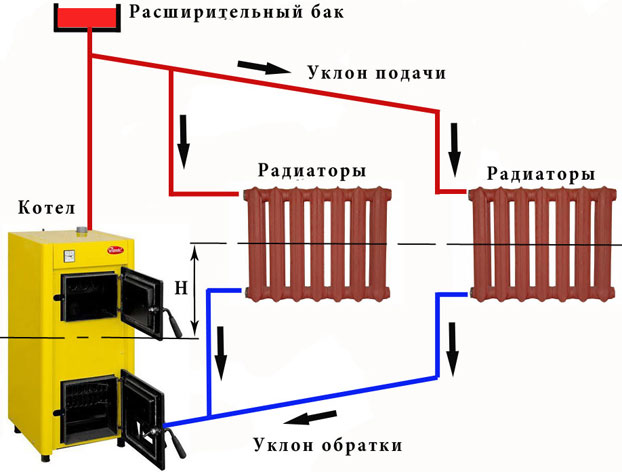
AT closed version Provision of space heating, the heat supply is regulated centrally, and the amount of liquid in the system remains unchanged. The consumption of heat energy depends on the temperature of the coolant circulating through the pipes and radiators.
In heating systems closed type, as a rule, thermal points are used in which hot water comes from a heat energy supplier, for example, a CHP plant. Further, the temperature of the coolant is brought to the required parameters for heat supply and hot water supply and sent to consumers.
When a closed heat supply system operates, the heat supply scheme ensures high quality of the DHW and an energy-saving effect. Its main drawback is the complexity of water treatment because of the remoteness of one heat point from another.
Dependent and independent heat supply systems
Both an open and closed heat supply system can be connected in two ways - dependent and independent.
A dependent way of connecting an open system means connecting through elevators and pumps. In an independent type, hot water flows through the heat exchanger.
Example of an open heat supply system on video:
For indoor heating, a closed and open heat supply system is used. The latter option additionally provides the consumer hot water. It is necessary to control the constant replenishment of the system.
Closed system uses water only as a coolant. It constantly circulates in a closed loop, where losses are minimal.
Any system consists of three main parts:
- source of heat: boiler, CHP, etc .;
- heat networks, for which the coolant is transported;
- heat consumers: air heaters, radiators.
Features of an open system
The advantage of an open system is its economy. Due to the length of the pipelines, the quality of water deteriorates: it becomes cloudy, acquires color, has an unpleasant smell. Attempts to clean it make the method of application expensive.
Heating pipes can be seen in big cities. They have a large diameter and are wrapped in a heat insulator. From them, bends are made to individual houses through a thermal substation. Hot water comes for use and to radiators of heating from a common source. Its temperature varies between 50-75 ° C.
The connection of heat supply to the network is carried out by a dependent and independent means, implementing a closed and open heat supply system. The first is to supply water directly - by means of pumps and elevator units, where it is brought to the desired temperature by mixing with cold water. An independent way is to feed hot water through a heat exchanger. It is more expensive, but the water quality of the consumer is higher.
Features of a closed system
The thermal main is made in the form of a separate closed loop. The water in it is heated through heat exchangers from the CHPP main. It requires additional pumps. Temperature conditions is more stable, and water is better. It remains in the system and is not taken away by the consumer. Minimal water losses are restored by automatic feeding.
A closed autonomous system receives energy from the coolant coming to the heat points. There the water is brought to the necessary parameters. For heating systems and hot water pipes, different
The disadvantage of the system is the complexity of the water treatment process. Also expensive is the delivery of water to heat points located far apart.
Pipes of thermal networks
At present, the domestic ones are in an emergency condition. In connection with the great wear and tear of communications, it is cheaper to replace the pipes for the heating main with new ones, than to engage in permanent repairs.
Immediately update all old communications in the country is impossible. When constructing or repairing houses, new pipes are installed in which the heat losses are reduced several times. Pipes for heating mains are manufactured using a special technology, pouring a gap between the inside steel pipe and a shell. 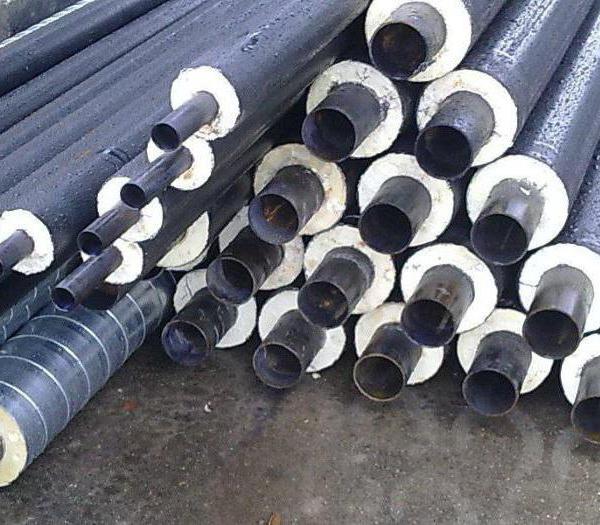
The temperature of the transported liquid can reach 140 ° C.
The use of polyurethane foam as heat insulation allows the heat to be saved much better than traditional protective materials.
Heat supply for apartment buildings
Unlike a summer residence or a cottage, heat supply apartment building It contains a complicated scheme for routing pipes and heaters. In addition, the system includes controls and security.
For residential premises, there are standards of heating, which indicate the critical temperature levels and permissible errors, depending on the season, weather and time of day. If one compares a closed and open heat supply system, the former better maintains the necessary parameters.
The public heat supply must ensure the maintenance of the main parameters in accordance with GOST 30494-96. 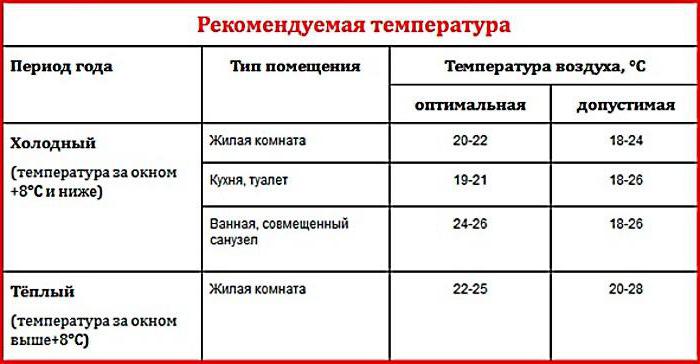
The largest occur on the stairwells of residential buildings.
Heat supply is mostly made using old technologies. Essentially, the heating and cooling systems must be combined into a common complex.
Disadvantages of central heating of residential buildings lead to the need to create individual systems. It is difficult to do this because of problems at the legislative level.
Autonomous heat supply of an apartment house
In buildings of the old type, the project provides for a centralized system. Individual schemes allow choosing types of heat supply systems in terms of reducing energy costs. Here there is the possibility of their mobile shutdown if necessary. 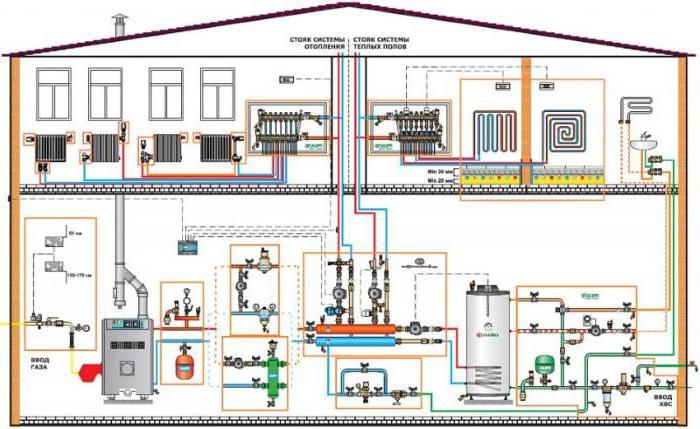
Design of autonomous systems is performed taking into account the standards of heating. Without this, the house can not be commissioned. Following the standards guarantees comfort for the tenants of the house.
The source of water heating is usually a gas or electric boiler. It is necessary to choose a method for flushing the system. In centralized systems, a hydrodynamic method is used. For autonomous, you can use chemical. In this case, it is necessary to take into account the safety of the effect of reagents on radiators and pipes.
Legal basis of relations in the field of heat supply
Relations between energy companies and consumers are regulated by the Federal Law on Heat Supply No. 190, which entered into force in 2010.
- Chapter 1 outlines the main concepts and general provisionsdefining the sphere legal framework economic relations in the heat supply. It also includes the provision of hot water. Approve general principles organization of heat supply, consisting in the creation of reliable, efficient and developing systems, which is very important for living in a complex Russian climate.
- Chapters 2 and 3 reflect the extensive area of authority of local authorities that manage pricing in the heat supply sector, approve the rules for its organization, record heat consumption and the standards of its losses during transmission. The completeness of power in these matters makes it possible to control the organizations of heat supply related to monopolists.
- Chapter 4 reflects the relationship between the supplier of thermal energy and the consumer on the basis of the contract. All legal aspects of connection to heat networks are considered.
- Chapter 5 reflects the rules for preparing for the season of heating and repair of heat networks and sources. It describes what to do for non-payments under the contract and unauthorized connections to heat networks.
- Chapter 6 defines the conditions for the organization's transition to self-regulating status in the field of heat supply, organization of the transfer of rights to own and use the heat supply facility.
Users of heat energy must know the provisions of the Federal Law on heat supply in order to assert their legal rights. 
Drawing up a heat supply scheme
The heat supply scheme is a pre-project document, which reflects the legal relations, the conditions for the functioning and development of the heat supply system of the urban district and settlements. In relation to it, federal law includes certain norms.
- for settlements are approved by the executive authorities or local self-government, depending on the population.
- For the corresponding territory there should be a single heat supply organization.
- The scheme indicates the energy sources with their basic parameters (load, work schedules, etc.) and range of action.
- Measures are specified for the development of a system for providing heat, conserving excess capacity, creating conditions for its uninterrupted operation.

The objects of heat supply are located within the boundaries of the settlement according to the approved scheme.
Purpose of the heat supply scheme application
- definition of a single heat supply organization;
- determination of the possibility of connection to the heating networks of capital construction facilities;
- inclusion of measures for the development of heat supply systems in the organization of heat supply.
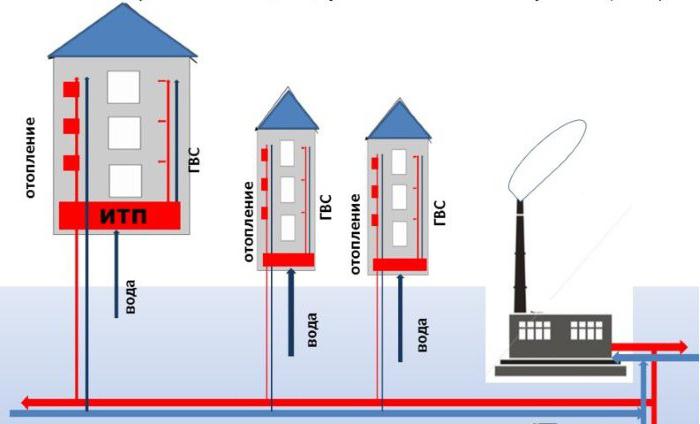
Conclusion
If we compare the closed and open heat supply systems, now the first one is promising. Hot water supply allows to increase the quality of the supplied water to the drinking water level.
Despite the fact that new technologies are resource-saving and reduce emissions to the atmosphere, they require significant investment. At the same time, there are not enough qualified specialists due to the lack of special personnel training and low wages.
The methods of implementation are due to commercial and budgetary financing, competitions for investment projects and other events.
It happens that private houses located within the city are located next to the paved central heating networks, and some even are connected to them. Of course, at the present time in the priority - individual heating, and centralized gradually disappears into the past. But if the house is already connected to the network or there are problems with an autonomous system, then it is necessary to use what is available. To work together the heat source with consumers, a dependent and independent heating system is used. What they are, as well as the pros and cons of both schemes will be outlined in this material.
Dependent (open) heat supply system
The main feature of the dependent system is that the coolant flowing through the mains networks directly enters the house. Open it is called because from the supply pipeline the heat carrier is selected to provide the house with hot water. Most often this scheme is used when connecting to the heating networks of multi-apartment houses, administrative and other public buildings. The operation of the dependent heating system is shown in the figure:
At a coolant temperature in the supply line up to 95 ° C, it can be sent directly to the heating devices. If the temperature is higher and reaches 105 ° C, then at the entrance to the house a mixing elevator unit is installed, whose task is water coming from the radiators, mix in a hot coolant to lower its temperature.
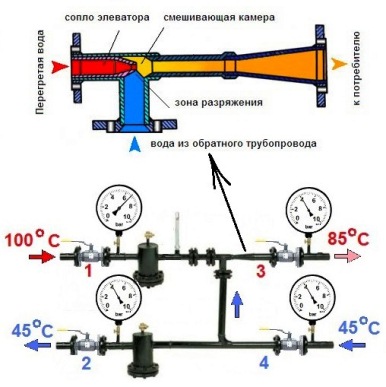
For reference. The centralized dependent heating system has a calculated and real temperature schedule. The calculated graph characterizes the maximum water temperature and in the open system it is 105/70 ºС or 95/70 ºС. The actual schedule depends on weather conditions and can be changed daily, it is maintained in the central heating station. When there are no severe frosts in the street, the temperature of the coolant is much lower than the calculated temperature.
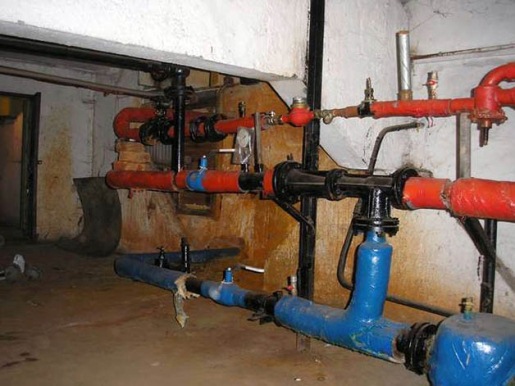
The scheme was very popular in the times of the USSR, when very few people worried about energy consumption. The fact is that a dependent connection with elevator mixing units works reasonably reliably and requires almost no supervision, and installation work and materials costs are quite cheap. Again, no need to build additional pipes for supplying hot water to houses, when it can be successfully withdrawn from the heat main.
But on this positive side of the dependent scheme ends. And the negative is much more:
- dirt, scale and rust from the main pipelines safely fall into all the batteries of consumers. Old cast-iron radiators and steel convectors have such trifles, but modern aluminum and other heating devices accurately rendered unmarketable;
- due to the reduction of water repair work and other reasons, there is often a pressure drop in the dependent heating system, or even a hydraulic shock. This threatens the consequences for modern batteries and polymer pipelines;
- the quality of the coolant leaves much to be desired, and it goes directly to water supply. And, although in the boiler room water passes all the stages of purification and desalting, the kilometers of old rusty roads make themselves felt;
- regulate the temperature in the premises is not easy. Even full-flow thermostatic valves quickly fail because of poor quality of the coolant.
Independent (closed) heating system
At present, when installing new boilers, an independent scheme for connecting the heating system has become more frequent. It has a main and additional circulation loop, hydraulically separated by a heat exchanger. That is, the coolant from the boiler or CHP goes to the central heat point, where it enters the heat exchanger, this is the main circuit. An additional circuit is a house heating system, the heat transfer medium circulates through the same heat exchanger, receiving heat from the network water from the boiler room. The scheme of the independent system is shown in the figure:
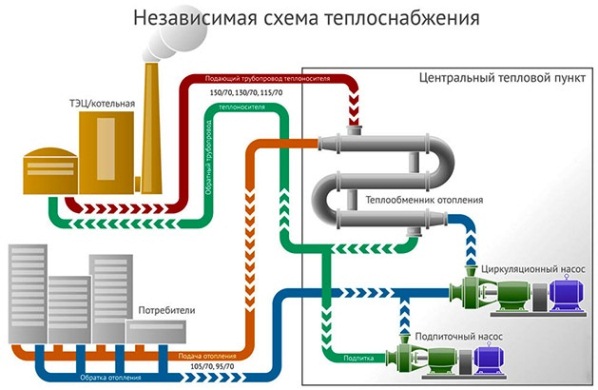
For reference. Previously, in such systems, bulky shell-and-tube heat exchangers, which occupied a lot of space, were installed. This was the main difficulty, but with the advent of high-speed plate heat exchangers this problem ceased to exist.
![]()
But what about the centralized supply of hot water, because now you can not take it from the highway, there is too high a temperature (105 to 150 ºC)? It's simple: an independent connection scheme allows the installation of any number of plate heat exchangers connected to the main pipelines. One will provide heat heating system at home, and the latter can prepare water for household needs. How this is implemented, shown in the diagram:
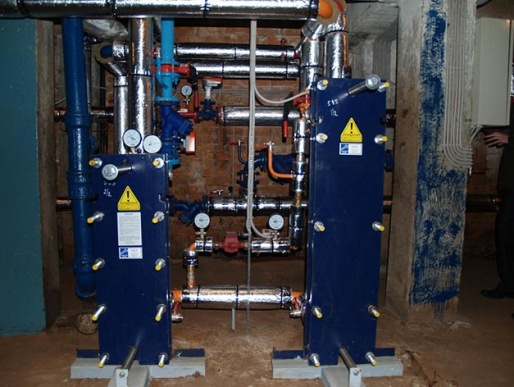
To ensure that hot water always comes at the same temperature, the DHW circuit becomes closed with the automatic return water supply. AT apartment buildings The DHW circulation circulation line can be seen in the bathroom, towel warmers are connected to it.
Obviously, the operation of an independent heating system has many advantages:
- the home heating circuit does not depend on the quality of the external heat carrier, the condition of the mains networks and pressure drops. All the load falls on the plate heat exchanger;
- it is possible to regulate the temperature in the rooms with the help of thermostatic valves;
- the coolant in the small circuit can be filtered and cleaned of salts, the main thing is that the pipes are in good condition;
- in the DHW system there will be water drinking quality, entering the house along the water main.
However, due to a poor quality coolant in central network It will be necessary to periodically flush an independent heating system, or more precisely, a plate heat exchanger. Fortunately, this is not so difficult. Another disadvantage is the higher costs of acquiring equipment, namely heat exchangers, circulating pumps and shut-off and control valves. But the closed system is safer and safer open, it more meets modern requirements and is better adapted to new equipment.
Conclusion
If, for some reason, you choose to connect to a centralized network, then an independent home heating system is preferable. Even if the temperature in the highway is low, it is still not worthwhile to supply this water to your system, it is better to separate it hydraulically from the central one. Provided that this possibility exists in the material plan, and if not - it is necessary to crash directly, according to the dependent scheme.













